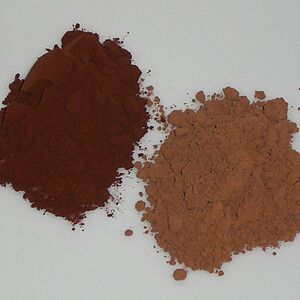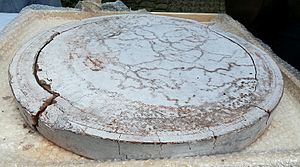Cocoa solids facts for kids
Cocoa solids are what's left of cocoa beans after most of the fat, called cocoa butter, is taken out. Imagine grinding roasted cocoa beans into a liquid; that's "chocolate liquor." When you press out the cocoa butter from this liquid, the dry stuff left behind is cocoa solids. Cocoa butter makes up a big part of the bean and helps chocolate melt nicely.
Cocoa powder is simply these dry cocoa solids, ground into a fine powder, with only a tiny bit of cocoa butter left. If it's not treated, cocoa powder tastes a bit bitter and sour. But there's also something called Dutch process cocoa, which is treated to make it less sour.
Cocoa powder also has special plant compounds called flavanols. These can be reduced if the cocoa is treated to make it less acidic.
Contents
What is Cocoa Powder?
Cocoa powder comes from cocoa beans. It has different physical properties depending on how it's made. There are two main types: natural cocoa and Dutch process cocoa.
Natural Cocoa Powder

Natural cocoa powder is made using a method called the Broma process. After the fats are removed from the cocoa beans, the dry parts are ground into powder. This is the kind of cocoa powder you often see sold in stores.
Natural cocoa powder has a light brown color. It's also a bit acidic. Because it's acidic, natural cocoa is often used with baking soda in recipes. Baking soda helps to neutralize the acid. This reaction creates carbon dioxide gas, which helps cakes and other baked goods rise and become fluffy.
Dutch Process Cocoa Powder
Dutch process cocoa is cocoa powder that has been treated with a special ingredient, usually a type of salt. This treatment makes the cocoa less acidic. It also changes its color, making it darker, and gives it a milder taste.
This type of cocoa is used in many modern chocolate products. You can find it in ice cream, hot chocolate, and lots of baked goods. The treatment makes the cocoa less bitter and helps it dissolve better in liquids. This is why it's great for making drinks like hot chocolate.
What's in Cocoa Powder?
| Nutritional value per 100 g (3.5 oz) | |
|---|---|
| Energy | 954 kJ (228 kcal) |
|
57.90 g of which fibre approx. 33 g
|
|
|
13.70 g
|
|
|
Protein
|
19.60 g
|
| Minerals | Quantity
%DV†
|
| Calcium |
13%
128 mg |
| Iron |
107%
13.86 mg |
| Magnesium |
141%
499 mg |
| Manganese |
183%
3.837 mg |
| Phosphorus |
105%
734 mg |
| Potassium |
51%
1524 mg |
| Sodium |
1%
21 mg |
| Zinc |
72%
6.81 mg |
| Other constituents | Quantity |
| Water | 3.00 g |
| Caffeine | 230 mg |
| Theobromine | 2060 mg |
|
Link to USDA Database entry
|
|
| †Percentages estimated using US recommendations for adults. | |
Cocoa powder is made up of different things. About 58% of it is carbohydrates, which give you energy. It also has about 14% fat and 20% protein, which helps build and repair your body. The rest is mostly water.
Cocoa powder is a good source of many important minerals. It has high amounts of manganese, magnesium, phosphorus, potassium, iron, and zinc. It also has some calcium. These minerals are important for strong bones, healthy blood, and many other body functions.
Flavonoids in Cocoa
Cocoa powder is rich in special plant compounds called flavonoids. These are a type of polyphenol. Flavonoids are found in many fruits and vegetables and are thought to be good for your health.
The amount of flavonoids in cocoa powder can change. It depends on how much the cocoa is processed and manufactured. For example, when cocoa goes through the Dutch processing (alkalization), the amount of flavonoids in it can be greatly reduced.
Safety Information
Cadmium in Cocoa
Sometimes, cocoa powders can contain a small amount of cadmium. Cadmium is a heavy metal that is found naturally in the soil in some places where cocoa beans grow. It can be harmful in large amounts.
Because of this, some places have set limits on how much cadmium can be in cocoa powder. For example, the European Union has a limit for cadmium in cocoa powder. Other countries and regions also have guidelines to make sure food is safe. Scientists and governments work to monitor these levels to protect people's health.
az:Kakao
See also
 In Spanish: Cacao en polvo para niños
In Spanish: Cacao en polvo para niños


